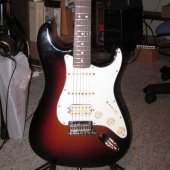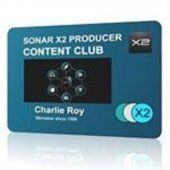-
Posts
8,664 -
Joined
-
Last visited
-
Days Won
30
Starship Krupa last won the day on August 3
Starship Krupa had the most liked content!
Reputation
7,071 ExcellentAbout Starship Krupa
- Birthday February 18
Recent Profile Visitors
The recent visitors block is disabled and is not being shown to other users.
-
After we had a discussion about "installer helper" services that plug-in installers install along with the plug-ins (always set to start automatically), I did some research and brushing up of my NT command line scripting. On my system, there are 5 companies' installer services, that is, services that must be running during the company's install process. Antelope Crow Hill Native Instruments Softube UJAM The only services out of these that I could find sending information over the network were Native Instruments' NTK Daemon and Antelope Audio's Manager Service. NTK Daemon is pretty chatty, Antelope Manager blipped out one small message at start, then shut up, even when I put Pocket Strings in a project. Still, I don't want unnecessary programs running on my computer. What to do? Services are usually managed manually via the Services management console. Start, stop, set startup method (Manual, Automatic, Disabled). You can do it this way, but as more of these silly services get installed, it gets to be a bigger chore. (what follows is for people confident with messing with this stuff, I am deliberately writing to a level that will filter out people who might get themselves into trouble) Services may also be managed using the SC shell command, via the command line and in scripts. To learn more about what it can do, open a command prompt and type SC. That will give you a list of the most common (and safest) commands, including Start and Stop. My research uncovered other commands that don't appear in that list, including the config command, which allows the user to set the startup method. Armed with this knowledge, I wrote 3 scripts that: Stops all of those companies' services Starts all of those companies' services Stops all of those companies' services and sets their startup to Manual Microsoft helps companies that don't want users to set their services to Manual by naming the manual startup parameter "demand." My scripts have been tested on my system, no guarantee that they will work on yours. In order to use them successfully, you must edit them to add any other services you wish to control and subtract any services you don't have on your system. In all cases, the services are not necessary when using the plug-ins, it's only the installer that depends on them. Use at your own risk, etc. etc. Any "trouble" you may cause with the SC command may be repaired using the Services Console or just running a company's installer again. To use these, first copy and paste them into Notepad or your text editor of choice, then save with the name of your choice, extension .CMD Important note: you MUST edit or comment out any lines that refer to services you don't have installed. If the script runs into a service that isn't there, it terminates immediately, and the rest of the services won't get their commands. To run them, right click and choose Run as administrator. The idea is to run the start script before you install any of these companies' products, then run the stop-and-set-to-manual script after the install is done. Setting them back to manual start is necessary because some of the installers check to see whether you've changed the startup and change it back to Automatic if you have. I won't upload the scripts as ready-to-run files. Anyone who can't manage the preceding instructions should just use the Services console to manage services. Script to stop the services: sc stop Antelope-Manager-Service sc stop crowhillinstallservice.exe sc stop NTKDaemonService sc stop NIHostIntegrationAgent sc stop softubeinstallerdaemon sc stop ujaminstallservice.exe Script to start the services: sc start Antelope-Manager-Service sc start crowhillinstallservice.exe sc start NIHostIntegrationAgent sc start NTKDaemonService sc start NIHostIntegrationAgent sc start softubeinstallerdaemon sc start ujaminstallservice.exe Script to stop the services and set them to manual start: REM these commands stop the running services sc stop Antelope-Manager-Service sc stop crowhillinstallservice.exe sc stop NTKDaemonService sc stop NIHostIntegrationAgent sc stop softubeinstallerdaemon sc stop ujaminstallservice.exe REM these commands set the services to manual startup sc config Antelope-Manager-Service start= demand sc config crowhillinstallservice.exe start= demand sc config NTKDaemonService start= demand sc config NIHostIntegrationAgent start= demand sc config softubeinstallerdaemon start= demand sc config ujaminstallservice.exe start= demand
-
Not likely. I have a hunch the devs are invested in the flat look and wish to maintain more control over the program's look than they had with the old Theme Editor.
-

Sonar Theme Editor Early Access is here!
Starship Krupa replied to Starship Krupa's topic in UI Themes
I expect this to change. The devs probably want to keep color theme editing behind the paywall. Simple text files would make it easy to even twist up a 3rd party color theme editor. -
The plug-in compatibility issue is always evolving and usually improving with the hosts and the plug-ins. When I check the release notes for updates on plug-ins I own, 9 times out of 10 there's something about fixing an issue with either one host or "some" hosts. In many cases, the fix for one host will also fix it in other hosts they weren't specifically targeting. Plug-in compatibility is an endless game of Whack-A-Mole for host developers. I'm sure they would say it's the worst thing to work on, because it involves code that they have no control over. If it's a more prominent plug-in developer, they're usually more likely to be willing and able to cooperate with the host devs on working out a solution. This is one of the reasons that it's good when your DAW is on the plug-in developer's compatibility list. If they advertise compatibility, they will likely work to ensure that their stuff is actually compatible. Fixes happen when users report to the DAW and plug-in developers that there's a problem, so it's good for everyone when someone reports an issue. Cockos are also known for their responsiveness to user issues, so yeah, you're likely correct. They may have figured out a way to retool their plug-in hosting.
-
By the time he got started, Opie had paved the way for successful sitcom actors to become successful film directors.
-
Oh that battle is long since lost. About the time it started to be SOP to have your personal computer connected to a central network. I just don't want these things using resources and potentially causing problems. As a former pro software quality engineer I know that all software has bugs. Any program or even process running on a system has the potential to have trouble with some other program or process, so I want as few running as possible.
-

Sonar Theme Editor Early Access is here!
Starship Krupa replied to Starship Krupa's topic in UI Themes
There's been no official recommendation that users not share themes, rather I think that having anyone sharing them publicly is unlikely because of the logistics involved. I created more than half a dozen CbB themes, and there's a surprising amount of labor overhead in testing a theme, then setting up a way to share it, then writing a topic on the forum, posting to Reddit, and Facebook. After the first revision gets out there, updating it is the same chore. People aren't likely to check the theme forum daily just to see if their favorite color scheme has been updated, so you'll wind up with earlier, presumably lesser, versions of your work out in the wild. All of that inspires a desire to feel secure that the theming system is stable before I put anything out there. I'd like to start as soon as possible, because the Free Tier blocks access to the Color Theme Editor. Free Tier folks have no way to create/edit their own, so they'll be dependent on others' efforts. Assuming that Free Tier will still allow you to install custom themes, just not edit them. I hope it doesn't also block the ability to use custom color themes. -

Sonar Theme Editor Early Access is here!
Starship Krupa replied to Starship Krupa's topic in UI Themes
No, and there probably won't be any until the feature is actually released. It's likely to change a great deal before then. -

Sonar Theme Editor Early Access is here!
Starship Krupa replied to Starship Krupa's topic in UI Themes
Because it's complex, clunky and outdated, perhaps? So far, they haven't. The color choices that you can make in the old custom color are all things that are minor and mostly hidden. Things like what colors you want the automation lines for surround channels. The colors set by the new Theme Editor are front-facing. -
They at least used to install something called Waves Local Server, upon which their preset browser kludge was dependent. Since it was still possible to browse presets using the old UI method, Waves Local Server could be disabled with no ill side effects. Antares, Antelope, Crow Hill, Native Instruments, Softube, UAD, and UJAM all install "installation helper" services that are set to start automatically. So far, I've been able to run their plug-ins just fine with the services turned off. If/when the time comes that some company starts shipping plug-ins that must have a service constantly running in order to function, that will be the time that I will start to refrain from using their products. This "installer helper" thing is a peeve of mine because That some plug-in companies permanently install an always-on services that are (supposedly) only used during plug-in install is ludicrous. There are any number of services on my systems that are set to Manual start and which are used by certain programs only when they are needed. The programs start them when they use them then turn them off when they're done. As much as I hate to don the foil hat, I suspect that these services also send usage (and other) data back to the home office. It's easy enough to see what programs are connecting to the network using Resource Monitor, a tool that comes with Windows, but I haven't checked any of these. I just turn them off. I don't know if it's significant that ALL of these companies offer free plug-ins. If you bother to do this, watch out, because most of the time, the next time you run the company's installer, it will helpfully set the service back to Automatic start. After all, if their stupid service somehow happens to get set to Manual or Disabled, it must have been unintentional, right? The fact that their installer programs are able to start the services AND set them back to running automatically tells me that they could just as easily start and stop them on an as-needed basis, which angers me further. I'd like to have a program or script where I could enter the name of a service or services and have it turn off the service and set it to Manual start without my having to open Services to do it.
-
Thanks for answering. Who knows why my computers didn't get the start menu shortcut, maybe there was a box I unchecked at some point or whatever. Yeah, good thing to install the Intro version, the T-RackS 6 freebie gives you very nice EQ and compressor. And IK Multimedia have been friendly in the past about allowing you to grow your collection of processors, they work with magazines and websites to have giveaways. That's how I got one of my very favorite FX, the T-RackS 670 Fairchild emulation. It showed me the wonders of mid/side dynamics and I also like its general coloration. Speaking of IK Multimedia's commitment to M/S processing, the Classic EQ that comes with Intro has their L/R-M/S widget, which allows you to use it in 3 different modes. The standard linked stereo, where both sides are EQ'd the same, unlinked stereo, where you can give left and right different curves, and M/S, where you can give mid and side different curves. I don't know for sure what the "stereo enhancement" control on Classic Compressor does, but it probably applies differing settings to M/S and/or L/R.
-
OMG, he even plays bass AND uses a DAW. It's now my mission to find out what DAW Joe Mora uses. Google AI doesn't know, but if it spiders this forum maybe one day it will think that he DOES use Sonar. What I got wrong in making up my imaginary Backline Joe is his generation. From his bio and photo he looks like an Xennial rather than the Boomer or Gen Jones character I had in mind. I'd use a different set of cliches for an Xennial roadie. He'd have had a cute barista in every city. The PC-centricism would have come from playing Quake at LAN parties. He would have picked up Cakewalk and a SoundBlaster Live for his Win 95 gamer box when one of his friends "graduated" to Pro Tools on a Mac, and he would have used AOL Instant Messenger. The real one has done some pretty cool stuff according to his LinkedIn page.
-

Sonar Theme Editor Early Access is here!
Starship Krupa replied to Starship Krupa's topic in UI Themes
TODG has determined that as of now, there's no known way to change the color of the Transport readout numerals. The only solution is to use a lighter color for the window background, which is set by Overrides/Transport Module/Display/Background. Foreground only sets the color for the smaller ones in the row at the bottom of the window. -
I've met @Backlinejoe. He's a veteran roadie, a dude who's traveled every highway in the US, big and small. Haulin', loadin' in, settin' up, breakin' down, loadin' out, and haulin' again. He's got stories, many of which would violate the forum rules. He's seen more Anvil cases than he has sit down meals. You don't know his name, but he's worked with 'em all, from the biggest ever to the never big. He once knew where to cop in every major city in the US, now he knows the best NA meetings in every major city in the US. You never want to wrap cable near him unless you know how to wrap cable. COVID-19 lockdown reminded him of why he chose the life of a rock 'n' roll nomad, he's just not suited to stay in one place that long. The first tour bus he boarded after it ended felt like going home. He got his first email address in the mid '80's before most of the world had ever heard the word "Internet" or knew what a modem did. He and the rest of the crew used to take turns with the one Compaq portable they had between them and he had the address of every artist relations rep, booking agency, and talent rep who had one. The Compaq made him a solid PC man, and he got the first version of Cakewalk that would do audio and has used it in some form for all his board recordings ever since. Late at night when the people are gone he likes to pick up his bass guitar, and play a song with a funky groove that is real as the day is long. That's Backline Joe, long may he run until he takes off to the great gig in the sky in the Rolling truck Stones thing that's been parked outside, waiting, his whole career.










